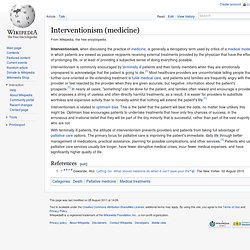

Interventionism (medicine) Interventionism, when discussing the practice of medicine, is generally a derogatory term used by critics of a medical model in which patients are viewed as passive recipients receiving external treatments provided by the physician that have the effect of prolonging life, or at least of providing a subjective sense of doing everything possible.

Interventionism is related to optimism bias. This is the belief that the patient will beat the odds, no matter how unlikely this might be. Optimism bias encourages patients to undertake treatments that have only tiny chances of success, in the erroneous and irrational belief that they will be part of the tiny minority that is successful, rather than part of the vast majority who are not. With terminally ill patients, the attitude of interventionism prevents providers and patients from taking full advantage of palliative care options. Superorganism. Artificial intelligence. AI research is highly technical and specialized, and is deeply divided into subfields that often fail to communicate with each other.[5] Some of the division is due to social and cultural factors: subfields have grown up around particular institutions and the work of individual researchers.

AI research is also divided by several technical issues. Some subfields focus on the solution of specific problems. Others focus on one of several possible approaches or on the use of a particular tool or towards the accomplishment of particular applications. The central problems (or goals) of AI research include reasoning, knowledge, planning, learning, natural language processing (communication), perception and the ability to move and manipulate objects.[6] General intelligence is still among the field's long-term goals.[7] Currently popular approaches include statistical methods, computational intelligence and traditional symbolic AI.
History[edit] Research[edit] Goals[edit] Planning[edit] Sacred Geometry. :FRACTAL ARCHITECT: Near-miss Asteroid Will Return Next Year. In this plot, the asteroid is the yellow dot, and Earth is green; the two orbits intersect twice per year. A preliminary orbit calculation shows that 2012 DA14 has a very Earth-like orbit with a period of 366.24 days, just one more day than our terrestrial year, and it 'jumps' inside and outside of the path of Earth two times per year. While an impact with Earth has been ruled out on the asteroid's next visit, astronomers will use that close approach for more studies and calculate the Earth and Moon's gravitational effects on it. Credits: Deimos-Space When it whizzes past Earth in 2013, a newly discovered asteroid is going to miss our planet - but not by much.
The 50 m space rock is expected to come closer than many satellites, highlighting the growing need to keep watch on hazards from above. An amateur team discovered the unusual asteroid, dubbed 2012 DA14, on 22 February. Time Travel. Time Travel: There's No Time Like Yesterday Bryan J. Méndez Depending on what you believe, the Universe began with a bang or was summoned into existence by some great force, or perhaps both or neither. Chytrid Fungus in Frogs Threatens Amphibian Extinction. Waves 4: Light, EM Spectrum, Color, Reflection. The Surprising Power of Solar Storms. Joule. In terms firstly of base SI units and then in terms of other SI units: One joule can also be defined as: Usage[edit] This SI unit is named after James Prescott Joule.

As with every International System of Units (SI) unit whose name is derived from the proper name of a person, the first letter of its symbol is upper case (J). However, when an SI unit is spelled out in English, it should always begin with a lower case letter (joule), except in a situation where any word in that position would be capitalized, such as at the beginning of a sentence or in capitalized material such as a title. News - Self-sculpting sand robots are under development at MIT. 3 April 2012Last updated at 13:46 ET The MIT team have built test modules with microprocessors and magnets to prove their theory Tiny robots that can join together to form functional tools and then split apart again after use might be ready for market in little more than a decade, according to researchers.

A team at the Massachusetts Institute of Technology says it has developed about 30 prototype "smart pebbles" and the software to run them. The sides of each cube are 1cm (0.4 inches) in length. Efforts are now focused on creating smaller models. The researchers from the university's Distributed Robotics Laboratory liken the ultimate product they are trying to develop to "self-sculpting sand".
Winter, Interrupted [viz] Developer Resources for Apps for Energy. This article is cross posted from OpenEI Blog.

More information about the Energy Department's Apps for Energy competition -- including a sign up form for competition updates -- is available here. The recent Green Button announcement by President Obama introduced the "Apps for Energy Challenge," intended to spur developers into making apps leveraging energy data to help define energy saving strategies, understand green button energy consumers, understand the green button energy market, and help collect even more user data. So where can you find data to help develop an app? The Night Sky This Month. Ozone, A Quick Overview.
Physics. Data.